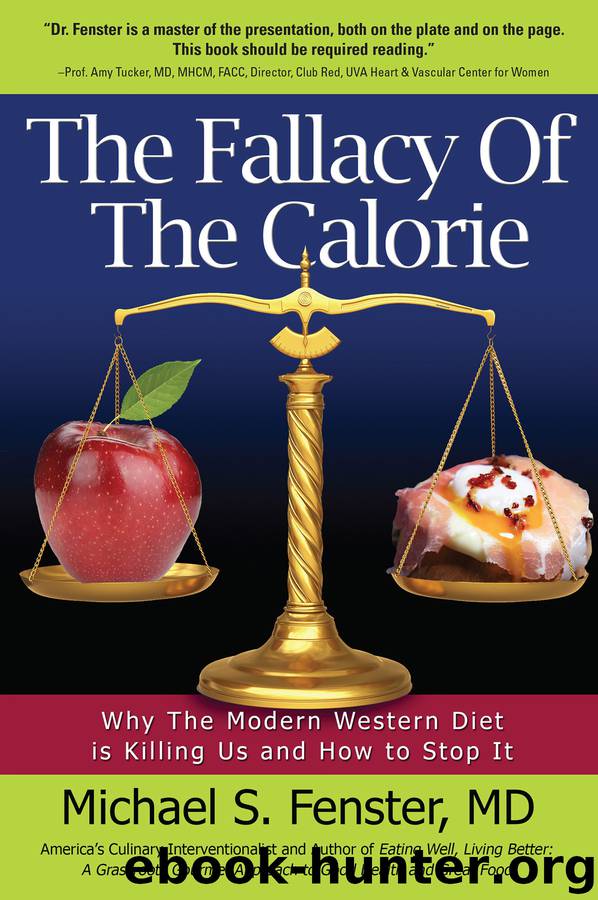The Fallacy of the Calorie by Mike Fenster

Author:Mike Fenster
Language: eng
Format: epub
ISBN: 9781940192895
Publisher: Koehler Books
Published: 2014-03-13T16:00:00+00:00
Salt: Blood, Sweat, and Tears
Without salt there is no life. We can give no blood, there is no sweat, and we can shed no tears. In the early days of prehistory, ancient humans sought out sources of sodium like modern-day herbivores and chimps. When our diet is primarily plant-based sodium becomes an essential supplement. Later, as hunter-gatherers, there was little need for exogenous sodium with the diet rich in animal flesh. If you eat enough meat, you can get all the sodium you need. In some contemporary hunter-gatherer societies where they consume a significant amount of meat, there is very little, if any, additional salt required in the diet.443
With the development of the Agricultural Revolution, salt became an intensely valuable commodity. The bulk of the diet was plant-based, with vegetables, cereals, and grains constituting the majority portion. Salt was necessary not only for human health, but also for the health of all the domesticated livestock. Salt was recognized for its health-giving properties. The Roman word for salt, sal, is where our word for salt originates. The Roman word derives from Salus, the Goddess of Health.
Salt was not only necessary for health, it was necessary for life. Prior to the Industrial Revolution salt was the major method of food preservation. If salt consumption is examined on an expanded timescale, we currently consume less salt compared to historical intakes. The Industrial Revolution with the changes to food pathways by transforming transportation have all but eliminated the dependency on salt for the preservation of foods. The average American currently consumes around 8 g of salt, sodium chloride, or about 3.4 g of sodium per day.444 This is over 50 percent less than just two centuries ago; and less than 10 percent of what sixteenth-century Swedes likely consumed.445
From a broad perspective, we are consuming less salt than we ever have. And the amount has stabilized over the last half-century. However, over the same fifty years there has been a dramatic increase in the incidence and prevalence of hypertension and heart disease.446 During the same time period the incidence and prevalence of the other disabilities and diseases of modern civilization have likewise reached dire proportions.
If we are currently consuming less salt than at any other time since the Agricultural Revolution and suffering more disease, where have we spilled the salt? What are the sinister demons? What has changed?
One of the major changes to the way we ingest our daily sodium has only occurred in the last fifty to seventy-five years. Our sodium no longer comes solely in the form of sodium chloride, or common table salt. It now comes in the form of a number of preservatives, stabilizers, enhancers, and additives: sodium bicarbonate, sodium ferrocyanide, monosodium glutamate, sodium nitrate, sodium stearoyl lactylate, sodium acetate, sodium acetate, sodium acid pyrophosphate, sodium adipate, sodium alginate, sodium aluminosilicate, sodium aluminum phosphate, sodium ascorbate, sodium benzoate, sodium bisulfate, sodium bisulfite, sodium carbonate, sodium carboxymethylcellulose, sodium caseinate, sodium citrate, sodium cyclamate, sodium dehydroacetate, sodium diacetate, sodium dihydrogen citrate, sodium dihydrogen
Download
This site does not store any files on its server. We only index and link to content provided by other sites. Please contact the content providers to delete copyright contents if any and email us, we'll remove relevant links or contents immediately.
A Court of Wings and Ruin by Sarah J. Maas(7651)
The Death of the Heart by Elizabeth Bowen(3552)
The Sprouting Book by Ann Wigmore(3543)
Better Homes and Gardens New Cookbook by Better Homes & Gardens(3525)
BraveTart by Stella Parks(3395)
Salt, Fat, Acid, Heat: Mastering the Elements of Good Cooking by Nosrat Samin(3108)
Sauces by James Peterson(3051)
Kitchen confidential by Anthony Bourdain(3009)
The Bread Bible by Rose Levy Beranbaum(3004)
Classic by Mary Berry(2942)
Solo Food by Janneke Vreugdenhil(2929)
Ottolenghi - The Cookbook by Yotam Ottolenghi(2871)
Martha Stewart's Baking Handbook by Martha Stewart(2796)
Day by Elie Wiesel(2720)
Betty Crocker's Good and Easy Cook Book by Betty Crocker(2681)
My Pantry by Alice Waters(2547)
The Plant Paradox by Dr. Steven R. Gundry M.D(2547)
The Kitchen Counter Cooking School by Kathleen Flinn(2488)
Hot Sauce Nation by Denver Nicks(2451)
